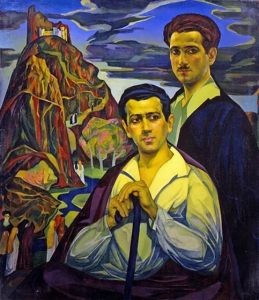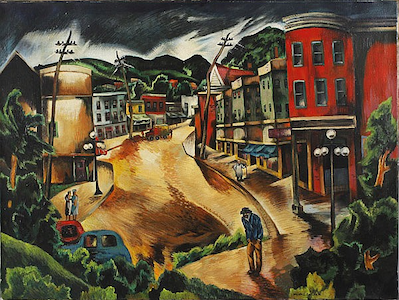
Biography
William Samuel Schwartz was one of a kind. He was born in the village of Smorgon in Russia, one of nine siblings in an impoverished family. Yet he eventually prospered in America, pursuing his twin passions of music and art with enough success to support himself wholly on these endeavors.
While Schwartz's family scarcely had money enough for any art material, he managed to gain a scholarship to an art school in Vilna 50 miles from home. He attended school there from 1908-1912 and followed other siblings to the United States in 1913.
He stayed first with a sister in New York and then with a brother in Omaha, NE. There he delivered newspapers and worked as a house painter while studying briefly with J. Laurie Wallace at the Kellom School. Kellom had been a student of Thomas Eakins and was a well-known portrait artist in Omaha.
In 1915 Schwartz moved to Chicago, hoping to attend the School of the Art Institute. He was able to gain a scholarship there in 1916, where he studied with Karl A. Buehr. Buehr was an impressionist painter and a traditionalist, but he recognized Schwartz's unusal talent and allowed him leeway in his artwork. Descriptions of Schwartz's early work make it sound like he was channeling the work of Picasso without, in fact, ever having seen any of Picasso's work. Schwartz graduated from the Art Institute in 1917 with honors in life drawing, portraiture and drawing. A painting of his was included in the annual show of the Art Institute in 1918.
While at the School of the Art Institute, Schwartz pursued another of his passions, taking singing lessons at the Auditorium Conservatory of Music. It was music that provided Schwartz with income in the 1920s, beginning with a performance in 1921. He performed in vaudeville, radio and opera, with generally positive reviews. His musical performances took him to a number of midwestern towns, some of which show up in his artwork.
Events in 1922 and 1923 were crucial to Schwartz's future. Wassily Kandinsky had a solo retrospective at the Art Institute in 1922. This gave American audiences their first real introduction to Kandinsky. And, while it's not documented that Schwartz attended this exhibit, his paintings show a definite influence of Kandinsky's style.
The second formative event of that period was his meeting in 1923 with Mona Turner, who was then married with two children. There started a life-long relationship between the two, leading ultimately to a marriage in 1939. But Mona appears in many of Schwartz's paintings, and the couple made trips together across the midwest.
Schwartz's artistic career blossomed at this point. His work appeared in an exhibition of Jewish artists in Detroit in 1926. And he was given a solo exhibition at the Art Institute in 1926. This was a remarkable achievement for a 30 year old artist, and it was followed by two other solo exhibits at the Art Institute in 1929 and 1935.
In 1929 Anthony Angarola, Schwartz's close friend and confidant since his student days at the Art Institute, died after an automobile accident in France. The Great Depression began soon after, and Schwartz sought work with the Federal Art Project. His mural "Mining" was part of the Century of Progress Exposition in 1933, and "Composers" was painted for the Glencoe Public Library in 1935. The same year he painted a mural "Chicago" for the Cook County Nurses' Home.
Beginning in 1924 Schwartz had started a series of abstract paintings that he called "Symphonic Forms." This series occupied him for another four decades. The first 14 paintings of the series were part of his acclaimed one-man show at the Art Institute in 1935.
Schwartz completed three commissions for Post Office murals: Fairfield, IL (1936), Eldorado, IL (1937), and Pittsfield, IL (1938). From 1934 on SChwartz was often to be found at Riccardo's Restaurant on Rush Street. There he met with artist friends Aaron Bohrod, Malvin and Ivan Albright, and Archibald Motley, Jr. At one point Schwartz even had an apartment above the restaurant. His artist comrades were all, like himself, modernist painters.
From 1942-1948 Schwartz worked with Associated American Artists and received a number of industrial commissions. He returned to abstract painting in the 1960s, producing some of his best work. By 1970 he showed signs of impending Alzheimer's disease, which led to his death in 1977.


Critical Analysis
Schwartz was one of a kind not only for his lifestyle but also for his painting style. He called himself a progressive painter, preferring not to be buttonholed with any conventional label. He was, in fact, talented enough to paint in any style he chose. His work was marked for the most part by intense color. But he was also a very capable draftsman, and he could emphasize different aspects of his talent in different parts of the same work. As he put it, art depended upon color, line and form. And great art required the harmony of these three elements. He visualized this harmony as something akin to harmony in music, and his 66 Symphonic Forms were meant as examples of this desired harmony. In, for example, his Pittsfield mural, his dramatic use of color is obvious; the forms of the ferry boat and hillside as simple and dramatic; and the exquisite lines of the bridge are virtuosic in presentation.
Schwartz declared that he never imitated. And while his work often brings to mind the ideas of Fauvism or Cubism or other trends in modern art, it's true that Schwartz's presentation is always original. It's not surprising that his work was popular throughout his career - and that it is refreshing to look at even today.
Murals
- Eldorado, Illinois - Post Office: Mining in Illinois
- Fairfield, Illinois - Post Office: Old Settlers
- Pittsfield, Illinois - Post Office: Champ Clark Bridge
References
- William S. Schwartz 1896-1977 (M. Christine Schwartz Collection). Notes on Schwartz by Wendy Greenhouse, PhD
- William S. Schwartz: Romantic Modernist (incollect). Insightful notes by Yen Azzaro.
- William Samuel Schwartz (1896-1977) (Illinois Historical Art Project). Insightful essay by Constance Poore, Ph.D. and Joel S. Dryer.
- Igor Voloshin, William Schwartz is a romantic modernist, Seagull Magazine May 22 (2018). (In Russian.)